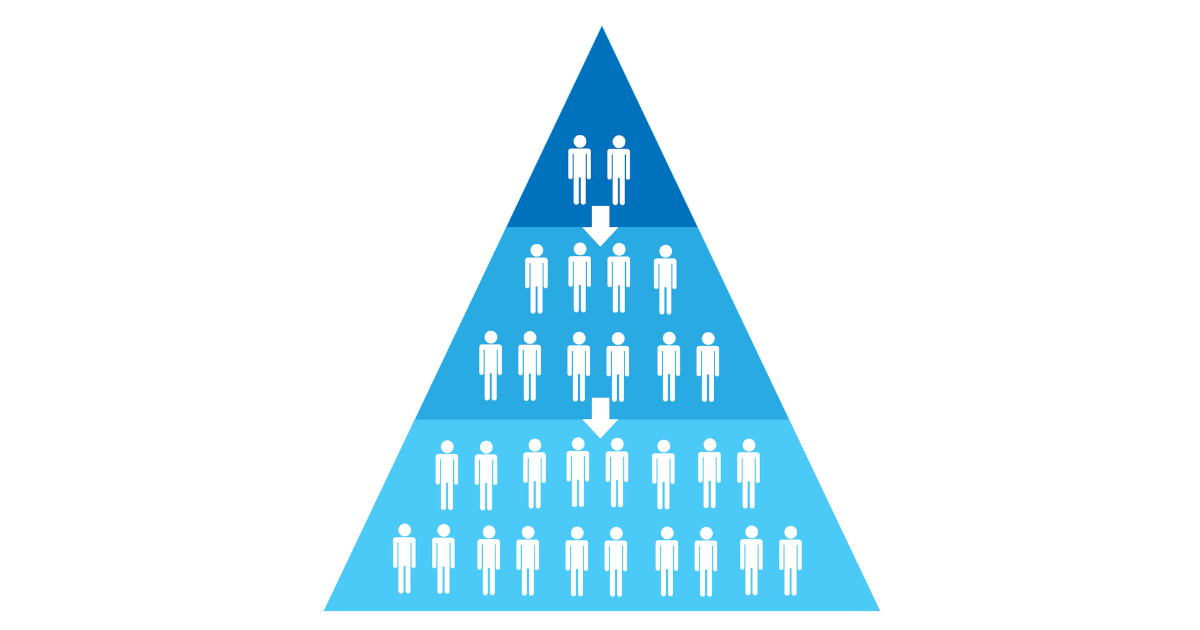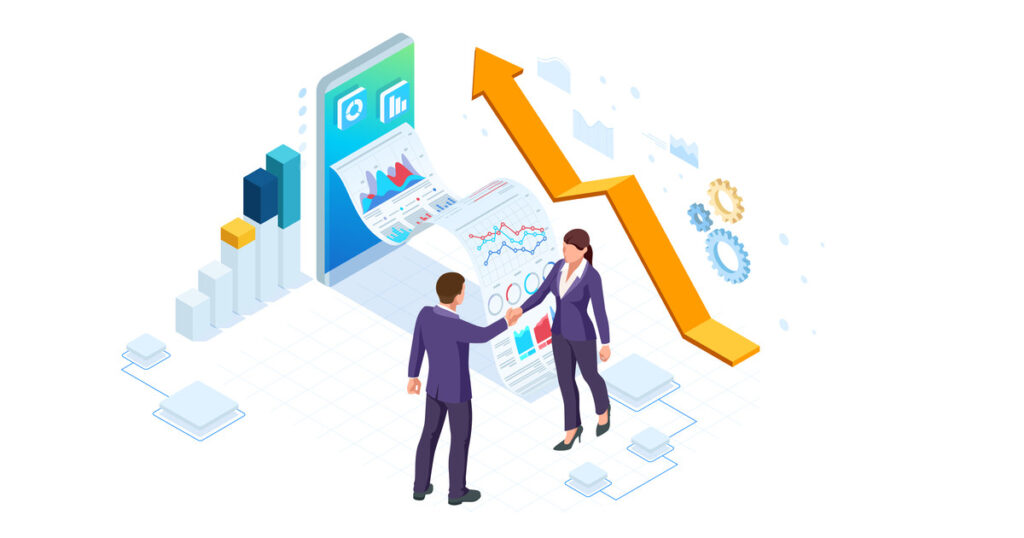B2B Lead Generation

Flipping the Script: Reversing the Marketing Funnel in B2B Marketing
The traditional marketing funnel – a model that illustrates the theoretical customer journey toward the purchase of a product or service – has long been upheld as a stalwart strategy in both B2C and B2B domains.
This funnel starts broad at the top with awareness and narrows down through interest, desire, and action. Each stage is designed to progressively refine the focus of potential customers.
But what if flipping this model upside down could unlock more effective strategies for customer acquisition and retention?
Enter the reversed marketing funnel.
By inverting the traditional funnel, the focus shifts to starting with a more targeted, highly engaged audience base and expanding outward. This isn’t just about flipping stages; it’s about rethinking how to connect more meaningfully from the first point of contact.
In this exploration of the reversed marketing funnel in B2B marketing, we delve into several critical areas:
- What is the Flipped Funnel Approach?
- Challenging the Status Quo: Why Reverse?
- Employing an Inverted Marketing Funnel: A Step-by-Step Guide
- Data-Driven Approaches and Continuous Refinement
- Conclusion: A Paradigm Shift
What is the Reversed Marketing Funnel?
The reversed marketing funnel, often termed an inverted or reverse funnel, fundamentally alters the traditional marketing approach by prioritizing the narrowest point first—focusing initially on those who are most likely to convert.
Unlike the traditional sales funnel, which starts wide by attracting a large audience and narrows down to the few who take action, the reversed funnel begins with a highly targeted base, aiming to expand influence through high-value customer interactions.
Key Features
- Targeted Engagement: Begins with individuals already interested or partially committed.
- Upside-Down Progression: Expands outward, aiming to widen influence after securing the most likely prospects.
Benefits
- Efficiency: Minimises waste by concentrating resources on likely converters.
- Enhanced ROI: Increases return on investment by focusing efforts on deeper, more meaningful engagements that are more likely to yield results.

What is the Flipped Funnel Approach?
The flipped funnel approach is a strategic inversion of the traditional marketing funnel. It represents a shift towards starting with strategies and tactics that aim directly at nurturing and converting the most promising leads first, rather than casting a wide net.
Key Differences from the Traditional Sales Funnel
- Focus on Conversion First: Prioritizes high-interest groups for immediate engagement and conversion, rather than leading them through the entire funnel.
- Expanding Outward: Utilizes successful conversions as a base to generate broader interest and engagement, effectively reversing the funnel’s flow.
Challenging the Status Quo: Why Reverse?
The conventional marketing funnel, while time-tested, often emphasizes quantity over quality, especially in its early stages.
It pours a vast audience into the top, hoping that a fraction trickles through to conversion at the bottom.
The reverse funnel, conversely, flips this methodology.
Here’s why this reversal might make logical and logistical sense in a B2B context:
- Quality Leads: By concentrating on a selected audience first, businesses can curate marketing strategies that cater to high-quality leads, ensuring more relevant engagements and solutions.
- Resource Optimization: With finite resources, focusing energy and budget on nurturing selected leads and clients could yield more significant ROI.
- Personalization: B2B purchasing often involves long-term relationships. A narrowed focus allows for enhanced personalization, aligning offerings closely with the specific needs and challenges of clients.
Enhanced Engagement and Customer Retention
In the flipped funnel model, “loving your customers” transcends traditional customer service.
It involves proactive engagement, personalised communication, and an emphasis on understanding and meeting customer needs. This approach fosters loyalty and encourages long-term relationships, which are vital for retention.
Benefits of the Inverted Funnel Approach
- Increased Customer Loyalty: By prioritizing existing or potential high-value customers, businesses can increase loyalty and reduce churn.
- Better Resource Allocation: Resources are directed towards nurturing deeper relationships rather than spreading efforts thinly over many leads.
- Personalisation at Scale: Tailoring experiences based on detailed insights from your most engaged customers can help personalise at scale, improving overall customer experience.
This strategic focus not only enhances customer retention but also builds trust and loyalty, which are cornerstones of successful B2B marketing.

Employing an Inverted Marketing Funnel: A Step-by-Step Guide
Implementing an inverted funnel approach in B2B marketing involves a strategic realignment of your sales and marketing teams to focus efforts on the most promising leads first.
Here’s a practical guide to get you started:
Step 1: Align Sales and Marketing Objectives
Begin by ensuring that both your sales team and marketing team share a unified goal. Alignment involves clear communication about target accounts that are most likely to convert, ensuring both teams focus their efforts cohesively.
Step 2: Targeted Engagement
Utilize digital marketing efforts to engage these selected accounts with personalized campaigns tailored to their specific needs. This precision in targeting helps in laying a strong foundation for deeper relationships.
Step 3: Cultivate Brand Advocates
After securing initial engagement, focus on transforming these clients into brand advocates. High-quality service combined with consistent support helps foster this transition, turning satisfied customers into vocal supporters.
Step 4: Expand Influence
Leverage the advocacy of your clients to amplify your reach. Use their testimonials and case studies as a means to enhance credibility and attract a broader yet relevant audience. This step utilises the influence of your advocates to extend your marketing reach.
By implementing these steps, you create a powerful synergy between your sales and marketing strategies, optimising the inverted funnel approach to maximise both efficiency and effectiveness in your B2B marketing efforts.
Data-Driven Approaches and Continuous Refinement
Employing an inverted marketing funnel requires a robust, data-driven approach.
Success hinges on continuously monitoring key metrics such as customer satisfaction, engagement levels, and referral rates.
This not only helps in identifying what works but also pinpoints areas that need improvement.
Utilising Analytics to Refine Marketing Strategies
To optimise your reverse funnel strategy effectively, focus on key performance indicators (KPIs) like conversion rates, sales performance, and the number of leads.
Regular analysis of these metrics allows for real-time adjustments, ensuring that your marketing efforts remain aligned with changing customer needs and market dynamics.
This continuous refinement ensures that your strategies stay relevant and impactful, driving better business outcomes.
Conclusion: A Paradigm Shift
Reversing the marketing funnel represents a significant paradigm shift in B2B marketing, moving from a mass marketing approach to a strategy that is more personalized and account-based.
This method starts with a focused effort on nurturing strong relationships with a select group of clients and gradually expands reach by leveraging these relationships to attract a broader audience.
By adopting the inverted funnel, your marketing efforts can become more effective, leading to better outcomes and a stronger market presence.
Embrace these best practices to truly transform your B2B marketing:
- Focus on Quality: Start with high-quality, targeted leads to ensure more effective engagement and better conversion rates.
- Enhance Personalization: Utilize detailed customer insights to offer personalized experiences that resonate deeply with your key audience.
- Optimize Resources: By concentrating efforts on the most promising leads, resources are used more efficiently, potentially yielding a higher ROI.
- Leverage Customer Advocacy: Transform satisfied customers into brand advocates to naturally extend marketing reach and influence.
- Continuous Improvement: Employ a data-driven approach to refine strategies continuously, adapting to market changes and customer feedback for ongoing relevance and effectiveness.
FAQs (Frequently Asked Questions)
What exactly is an inverted marketing funnel?
An inverted marketing funnel flips the traditional marketing funnel, focusing initially on a smaller, highly targeted group of potential customers. This approach prioritizes deep engagement and high-quality leads from the start, expanding outward as relationships solidify.
How does the inverted funnel approach benefit B2B marketing?
In B2B marketing, the inverted funnel approach enhances personalization and customer engagement, ensuring that marketing efforts are concentrated on prospects most likely to convert. This leads to better resource utilization and potentially higher conversion rates.
What are the key metrics to track in an inverted funnel strategy?
Key metrics include customer satisfaction, engagement levels, conversion rates, and referral rates. Tracking these helps marketers refine strategies continuously and adapt to changing customer needs and market conditions.
How can companies implement an inverted funnel effectively?
Companies can implement an inverted funnel by starting with targeted engagement of key prospects, developing these relationships into brand advocacy, and using success stories to attract a wider audience. Alignment between sales and marketing teams is crucial to ensure consistent messaging and goals.

About the Author
John Horsley, CEO of Demand Exchange, boasts over 20 years in B2B tech marketing. Partnering with leading technology businesses, he's pioneered growth-focused campaigns. Founder of Digital Doughnut and Digital Marketing, John's made waves on LinkedIn, equipping marketers with key insights. A sought-after speaker and thought leader, his innovative approach continues to influence the B2B marketing landscape.
About the Author

John Horsley, CEO of Demand Exchange, boasts over 20 years in B2B tech marketing. Partnering with leading technology businesses, he's pioneered growth-focused campaigns. Founder of Digital Doughnut and Digital Marketing, John's made waves on LinkedIn, equipping marketers with key insights. A sought-after speaker and thought leader, his innovative approach continues to influence the B2B marketing landscape.